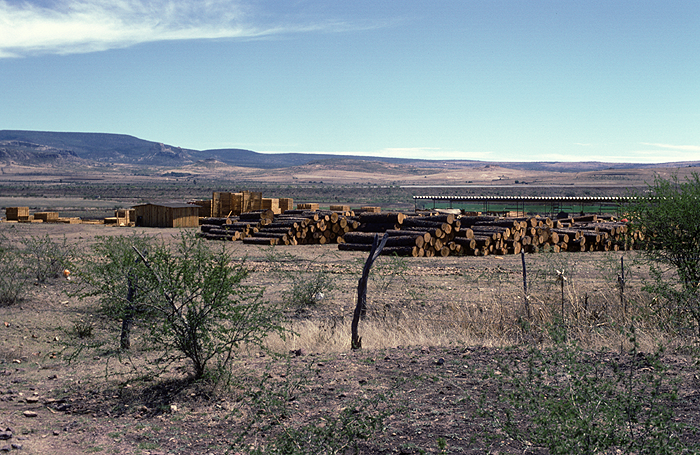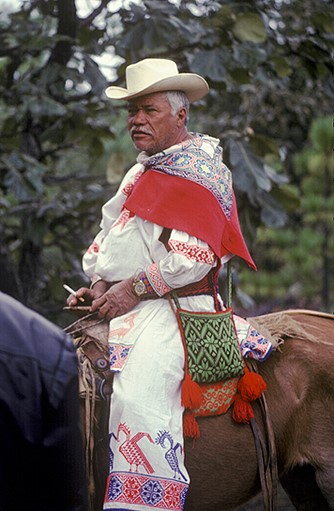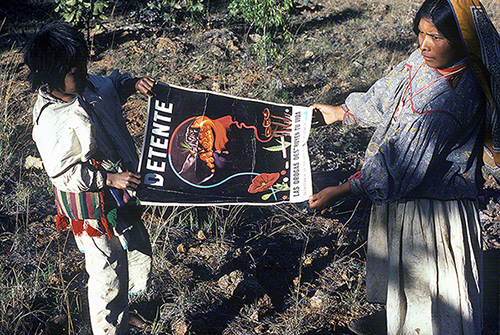Notes on Wixárika History: Recent History

Clandestine Sawmill on the Outskirts of the Huichol Sierra ©Juan Negrín 1981 2025
The government has found it very difficult to ‘civilize’ the Huichol and integrate them as a dependent productive working class in the mountains. After independence was achieved from Spain in 1810, the laws of the reform passed under Benito Juárez during the 1850’s, restrained the power of the Catholic Church, but they also stopped recognizing Indian colonial land rights. Soon the Huichol, Cora, Tepehuano and Mexicanero Indian groups of the Western Sierra Madre were further dispossessed of their territory by their mixed blood neighbors. They rebelled, eventually uniting under Manuel Lozada, who joined French invading forces until they were stopped at Guadalajara, Jalisco, in 1873. As a consequence, many of their land holdings were being disenfranchised in the late nineteenth century, when the first secular ethnographers were visiting them.
The initial impact of the Mexican revolution (1910 and the following decade) on the Huichol was not significant until the conservative Catholic population of the state of Jalisco, among others, began a grass-roots counter revolution that escalated into ‘la guerra de la cristiada’. Most Huichol were anti-cristeros, but some were convinced to join forces with the Catholics, believing that by doing so they would regain the lands they had under the colonial regime. There were internecine battles between communities, notably San Sebastián pro-cristeros against Santa Catarina anti-cristeros. The government had halted the Cristiada by the mid 1930’s, when Robert Mowry Zingg arrived in the Huichol territory of Tuxpan de Bolaños. Otto Klineberg also resided on an extended ranch in the community of San Sebastián for six weeks around that same time, according to data he published in American Anthropologist.
The Revolution wound up benefiting the Indians in general, after the government theoretically began to recognize their communal land rights under President Lázaro Cárdenas (1934 to 1940), setting the legal framework for them to recover some of their early colonial land titles. Founded on this principle, the Huichol have continued their struggle to obtain resolutions that recognize the core of their original territory. In 1965, this area was a little over four thousand square kilometers, a small portion of their land in the early stages of colonization. It was not until the early 1960’s that the Federal Government began to take a steady interest in the Huichol region. In 1964, the first landing strip was built beside the headquarters of the community of Tateikié (Our Mother House), as the Huichol call the community of San Andrés Cohamiata. Shortly thereafter, numerous government bilingual schools were introduced, along with other dirt landing strips, and work was initiated to improve their health care.
The dirt roads, which began penetrating the periphery of their communities after the mid 1970’s, quickly served to enrich the lumber companies. Much of their high plateau area was then placed under territorial dispute by the neighboring Mestizos, while the virgin forests of ancient pine trees near the shoulders of the roads were plundered without any benefit to the Huichol. Dirt-road construction reached the headquarters of San Andrés from the northwestern town of Ruiz, Nayarit, and from the northeastern town of Huejuquilla el Alto, Jalisco, by 1974. Soon thereafter, they penetrated the communities of San Sebastián and its annex of Tuxpan de Bolaños, to carry out severe logging efforts from Huejuquilla and Bolaños, Jalisco. Since 2004, even the central community of Santa Catarina is semi-connected by a rough dirt road. The government of President Vicente Fox settled some land claims for the Huichol along the southern road opened from the mining headquarters of Bolaños in the east, to Tepic, Nayarit, in the west, where labor is required for tobacco, sugar cane and crafts. Cattle-grazing has started taking its toll by further eroding the soil, and diseases like tuberculosis have spread at times.
In the long term, the Wixaritari (Huicholes) have adapted to change by concentrating on their values and

Photograph ©Juan Negrín 1980 - 2025
exploring the rest of the world with dignity. They have been ingenious in escaping deep acculturation and retain an alternative culture by relying on their traditional leaders, now backed by an intelligentsia of more literate members linked to the outside world. Their resistance is centered on the primordial female oracular ancestor, Tacutsi Nakawé, who advises them to avoid the assault by foreseeing it; she foretold the deluge and spawns growth out of darkness.
Three new leaders were elected by consensus for three-year terms at each community headquarter to correspond with the National Institute of Indian affairs once it started functioning in 1951. They form a body called the ‘presidencia de bienes comunales’ headed by the president of communal goods, who works in agreement with the traditional authorities, directed by the tatuani (the governor who is elected for a term of one year), and his assistants who are selected by the dreams of the theocratic elders.
Land was rescued with the government’s backing, although the Indians were not always happy with the intermediaries the government chose. The most famous among them was Pedro de Haro, about whom Fernando Benítez and Phil Weigand wrote, and who reclaimed a significant portion of land for the community of San Sebastián. He was a nine year old mestizo child when he was adopted by the Huichol. He fought for the land rights of the community where he had been raised and he mastered many of their customs as his own. His efforts were highly important for this community, although he was not able to recover the land titles in Los Amoles and other areas where the mestizos have taken over what were once Huichol ranches. He served in the unique position of president of the supreme council of the Huichol, until the government replaced him in 1976. His successor, Maurilio de la Cruz Ávila, was hand picked by outsiders and served poorly for 9 years, while the forests were plundered, the renting of grazing lands to Mexican neighbors was encouraged, and the building of dirt roads reached its peak. The position of supreme council was eliminated after a series of legal confrontations in 1985.
The traditional authorities and the council of elders (kawiteruxisi) have been more ignored by the Mexican Government since the beginning of the 1990’s, when it centralized the Wixaritari of Jalisco in an organization called Union of Indigenous Communities of Jalisco (U.C.I.J.), promoting a new top leader as its president each year from one of the Huichol communities. Most outsiders ignore the Wixaritari today as much as ever and so-called anthropologists quote them talking about a pantheon of gods and goddesses when these terms do not really correspond to their native language. Otherwise, they simplistically repeat what honest naturalists and explorers (Lumholtz), or the first ethnographers (Diguet and Preuss), had researched more zealously between 1895 and 1907, then Zingg in 1934.
The Wixaritari are amused, when they are not irritated, by the vast array of people who only associate them with the peyote cult of their purportedly folkloristic culture. Serious researchers never gave them credit for even having a notion of how to use verbs in their language, to the extent that Diguet decided to try to teach them how to conjugate an equivalent of the verb ‘to be’, so they could better express themselves . Thanks to the work of McIntosh and Grimes in the late 1950’s, westerners recognized these people have a sophisticated grammar. Their labor was done for evangelistic purposes, and they never studied the Wixárika religious terminology in depth. New research has been carried out on their language that may yield interesting fruits at the University of Guadalajara by José Luis Iturrioz Leza. However, in our opinion the Huichol student who is faced with also transcribing Spanish, should learn to transcribe his language using Hispanic phonetics with outstanding modifications noted. It appears a different task to transcribe Wixárika for the Hispanic reader than for the English reader. The key to understanding their language is its etymology, which is not easily accessible.
As Jay Fikes points out in his book, some anthropologists have acquired fame writing semi-fictitious work on the Huichol and other native groups without even exploring them within their territory. For a long time, the Mexican government made it clear to the Huichol that any outsider visiting their communities might be denied entry, particularly foreigners, unless they carried special papers recommending them on behalf of the state or federal government, (frequently the National Institute of Indian Affairs, I.N.I., which has been renamed the Comisión Nacional para el Desarrollo de los Pueblos Indígenas or C.D.I.). Thus, the government upheld the powers of the traditional authorities to maintain a nation within a nation, unless it recommended these outsiders. After the murder of San Antonio Express-News reporter, Philip True, in a remote extreme of the Huichol community of Tateikié in December of 1998, the government of President Vicente Fox worked to get an agreement for eco-tourism from that community. An infrastructure, consisting of 9 cabins and a crafts store, was installed for tourists in the community in early 2006. This agreement goes against the grain of most Wixaritari, who have seen their sacred spots plundered over the years, first by the Church and later by pseudo- anthropologists, both in connivance with government cronies and on their own.

Photograph ©Juan Negrín 1986 - 2025
Powerful outside forces are surrounding them with great scourges like drug plantations of poppies and marihuana. Others are pushing pesticides and herbicides without any precautions causing a great rise in the rate of cancer among this previously healthy population. The latter substances were introduced under the government’s Plan Huicot on a large scale, impoverishing the biosphere of complementary nutritive resources, like the spring-onions, small tomatoes, and amaranth to mention a few. Beer, sodas, potable water in plastic containers, potato chips and other junk foods and batteries are staples at all the local stores.
Major plans have been underway since February of 2003, to build a new maintenance road for posts and electric cables that is meant to stretch through the heart of the Wixárika territory, connecting the northwest and the southeast. In the midst of this new road are sacred spots surrounding Teacata, where the natives (including Coras and Tepehuanos) were purported to have united to resist the Chalchihuites Empire in the time of the Toltecs. As you may read in the Wixarika Web site’s current news section, the community it affects most directly had asked the government to halt work on the road in that area, and to suspend the electrification program, because of its proximity to sacred sites used for educational and spiritual purposes by the Wixaritari. Opposition has delayed the road’s progress and it is hoped that in the end it will avoid the sacred areas. Although the more conservative natives are not against solar energy, they are against cable electricity that would make them dependant on the Federal Commission of Electricity for maintenance, and they fear it would concentrate the population along roadsides, near the wires, instead of around the dispersed water holes and springs.
Since the 1990’s, the Mexican government has invested large sums of money into building colossal hydroelectric dams in the area of Northwestern Mexico, where its largest river system, the Río Grande Santiago - Lerma, flows into the Pacific Ocean after receiving water from its tributaries in the Sierra Madre. This started with the construction of the dam at Aguamilpa which had a record height of 191 meters. With the necessary credits they went on to build the country’s second tallest hydroelectric dam, El Cajón, in Santa María del Oro, an archaeological site near the mouth of the river into which the waters of the Huichol canyon flows. Its main wall is 186 meters high and the dam was inaugurated in 2006, near the end of Fox’s presidency. This dam represents an overwhelming ecological and cultural devastation, as we can foresee the water table rise and plunge unexpectedly. The work on El Cajón began with local opposition from the peasants who lost their land without redemption, although it was flaunted as President Vicente Fox’s major economic project. The site of this dam is only 50 miles inland from where the gigantic dam of Aguamilpa was finished in 1995, and it taps into the same water sources. New plans now call for building a third dam with a wall 210 meters high to the east of El Cajón in a spot called La Yesca, where the waters of the Santiago and the Bolaños rivers nearly merge to the southeast and west of the Sierra. The result of the first two dams has been the destruction of regional fauna, from fish, butterflies, bees, birds, caiman and flora, besides the likely privatization of water, and the displacement of native inhabitants from flooded areas. Not surprisingly, the project to develop the Huichol, Cora, and Tepehuano native region was called “Plan Lerma,” because of the river area the government expected to tap. The program was renamed Plan Huicot in 1964, after the three main native groups of the region who have still not been fully integrated into the mainstream of modern Mexican society.
© 2006 Juan Negrín, All rights reserved
Bibliography:
Fernando Benítez, Los Indios de México, Volume II, Ediciones ERA, S.A., Mexico, 1971
Patricia Díaz Romo y Samuel Salinas Álvarez: “Plaguicidas, tabaco y salud: el caso de los jornaleros huicholes, jornaleros mestizos y ejidatarios en Nayarit, México, 2002. Proyecto Huicholes y Plaguicidas
Léon Diguet: « Idiome Huitchol-Contribution à l’étude des langues mexicaines »Extrait du Journal de la Société des Américanistes de Paris. Nouvelle série, tome VIII, 1911.
Jay C. Fikes, Carlos Castaneda, Academic Opportunism and the Psychedelic Sixties, Millenia Press 1993
Joseph E. Grimes, Huichol Syntax, Mouton & CO. London, The Hague, Paris, 1964.
Carl Lumholtz, M.A., Unknown Mexico, Volume II. London-Macmillan and Co., Limited. 1903.
Juan B. McIntosh & José Grimes, Vocabulario Huichol-castellano Castellano-huichol, Institute of Summer Linguistics, Mexico 1954
Carl Lumholtz, M.A.: “Symbolism of the Huichol Indians”, Memoirs of the American Museum of Natural History, Volume III, Anthropology II, May 1900
Konrad Theodor Preuss: “Fiesta, literatura y magia en el Nayarit. Ensayos sobre coras, huicholes y mexicaneros de Konrad Theodor Preuss” Jesús Jáuregui y Johannes Neurath. Compiladores. Instituto Nacional Indigenista. Centro Francés de Estudios Mexicanos y Centroamericanos. 1998
Beatriz Rojas: “Los Huicholes en la Historia” Centro de Estudios Mexicanos y Centroamericanos/El Colegio de Michoacán/Instituto Nacional Indigenista, 1993.
Phil C. Weigand: “Ensayos sobre El Gran Nayar entre coras, huicholes y tepehuanos” Centro de Estudios Mexicanos y Centroamericanos/Instituto Nacional Indigenista/El Colegio de Michoacán, 1992.
Robert Mowry Zingg, Report of the Mr. & Mrs. Henry Pfeiffer Expedition for Huichol Ethnography: The Huichols, Primitive Artists, Stechert and Co., New York 1938
NOTES on transcription:
We use the x in Huichol words to indicate a sound that varies between an English sh sound, as in ‘she’ or a French j sound as in ‘je’, and a Spanish rolled ‘rr’ sound, as in ‘rey’. Western Huichol use it more as an ‘rr’ sound, whereas in the eastern section they use the softer ‘sh’ sound. It is used in the term Mexica.
We use the ü symbol in Huichol words to indicate a sound that is close to the German equivalent or to the French u sound. Sometimes this sound is close to the ‘ea’ sound in ‘early’, or the French ‘e’. It has often been recently transcribed as a + symbol. Grimes transcribed it as ï.
The other sounds are English equivalents for vowels and consonants that are generically Latin. The accentuation is used according to Spanish rules.





